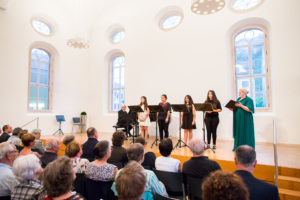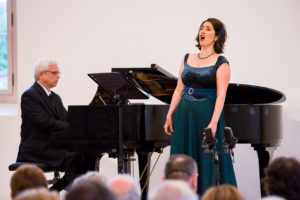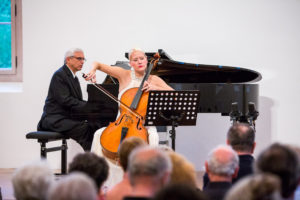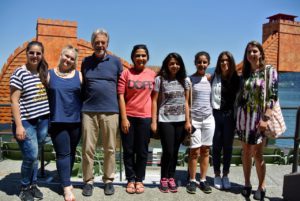On Saturday, the museum welcomed performers from both near and far for a concert featuring the music of the Hohenems-born composer Salomon Sulzer, Franz Schubert, and Sulzer’s sons, Julius and Joseph.
The performers including American pianist Lorne Richstone, Israeli-born vocalist Shira Karmon (who now lives in Vienna), Finnish cellist Liina Leijala (who comes by way of Ramallah, Palestine and Vienna), Austrian vocalist Veronika Dünser (from Vorarlberg), Berlin-based pianist Karl Kronthaler, and four Palestinian students from East Jerusalem: Rita Tawil, Jamileh Zaatreh, Hiba Awad, and Sama Shafea.




It was a unique (and extremely talented) ensemble. In the words of its creators, the purpose of the production was to “baut Brücken zwischen den Welten,” or build bridges between worlds. Indeed, the show seemed to bridge several different worlds: the 19th century compositions of Schubert and the Sulzers were performed by contemporary musicians; vocalists from Austria and Palestine were accompanied by pianists from Germany and the United States; the show itself bridges the gap between Austria and Jerusalem, where its performers will travel later this year.
Although the performers will continue their tour, the show also had a special connection to Hohenems.
Salomon Sulzer was born in Hohenems in 1804. He rose to the position of choirmaster at the synagogue by age 16 and, after moving to Vienna in 1826, became known for his compositions, both Jewish and secular. According to lore, non-Jews often came to the temple in Vienna, just to hear him sing. He also worked alongside many famous composers, including Schubert.
To many people, Sulzer represents a classic example of Jewish coexistence within Europe. Although he admittedly lived before anti-Semitism became a potent political force, his music nonetheless united Jews and non-Jews.
The auditorium which held the concert bares Sulzer’s namesake, and is also the building that housed the former Jewish synagogue, originally constructed in 1771. Although the synagogue avoided substantial damage during Kristallnacht (The Night of the Broken Glass on November 9, 1938), most objects of historical and religious significance had already gone missing following the Anschluss (the German annexation of Austria in March 1938). Many of these objects have never been found. After the forced disintegration of the Jewish community of Hohenems, the town seized the building in 1940.
Since there was no Jewish community in Hohenems after 1945, the synagogue was restituted to the Jewish community of Innsbruck. The town of Hohenems purchased the building in the early 1950s and converted it into a fire station, effectively removed all traces of religious or spiritual significance along the way. The building was used as a fire station until 2001, and, after considerable reconstruction, opened as a music hall in 2004.
The concert series continues in Vienna on Tuesday and in Jerusalem later this year.

Thank you and bravo Jessica! A wonderful text and beautiful souvenir of our first Wanderer-days in Hohenems!
Dear Petra,
You must be highly complimented on your excellent reports. We have a particular interest in Austrian travel. My parents and I lived in Siebenhirten, then a southern suburb (now incorporated into Wien as the 23. Bezirk). My father was Gemeinde -Arzt there until the Anschluss drove us out and we were fortunate enough to be able to emigrate to the USA in 1939. We have traveled in Europe every summer by rental car and have experienced areas and sights rarely seen by tour groups. My grandparents are buried in the Zentral Friedhof and we visit there to care for the maintenance of their graves and also visit the many other Jewish sites throughout Austria. And so we accidentally came across Bregenz and Hohenems in 1995, just after the museum opened. Since then we have visited the museum and cemetery many times and have admired the progress it has made. We are proud supporters of the American Friends of the museum as well.
Since you travelled to Vienna we have many important pictures of Jewish interest of Vienna (Theodor Herzl -Platz, Tel Aviv Beach ,Stolpersteine, etc.), Salzburg, Innsbruck and Hohenems ,all of which might be of interest to you. In particular I have an interesting shot of how Hohenems celebrated Sulzer’s 200th birthday in 2004 and how the Autobahn near Hohenems has signage of the Juedisches Museum. If you will giv me your e-mail address I will gladly send you these pictures.
Keep up your good work as ambassador for us!
Eric and Doris Billes
Was this comment intended for me? If so, I’d definitely be interested in the photos–send an email to jpiper231@gmail.com.
Cheers,
Jessica
Yes, it was. Sorry bout the misnomer. I will send them to you soon.
Alles Beste!
Eric Billes